Search tips for ScotlandsPeople
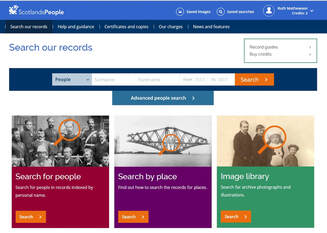
If you have discovered that some of your Irish relatives made their way to Scotland and you have, of course, perused my "Settling under the Saltire" page for advice, you will no doubt be grappling with the ScotlandsPeople website to try to find their records.
Whilst it is relatively straightforward to use it is not without its quirks and, quite frankly, problems and inconsistencies. A recent upgrade immediately prior to the welcome release of the 1921 Scottish census has not gone swimmingly to say the least and has been fulsomely picked apart on the Old Scottish blog. There is some seriously good advice published there born of diligent fruitless searching and earlier blog posts also referenced, so have a good read if you are experiencing similar confusion. Some of the inconsistencies actually go well beyond annoying, especially if you are trying to find folk in Coupar Angus! There has been a healthy clamour for a user group for this site for many years, but the National Records of Scotland remain shy of engaging with their paying public in this way.
That said, there is still plenty of content that does work well. The generic first screen, pictured above is very simple and good for casting your net very wide to begin with. However, once you get to the search screens specific to each source, then there is quite a lot of technical flexibility for searching. However, I'm not going to picture every screen and give you a step-by-step lesson in how to use them. What I can do, as ever, is give you some practical advice based on my own experiences and observations. There are quite a few of them listed under bold headings and with wee bits of the screens to illustrate what I mean - be sure to scroll to the bottom to see them all.
Whilst it is relatively straightforward to use it is not without its quirks and, quite frankly, problems and inconsistencies. A recent upgrade immediately prior to the welcome release of the 1921 Scottish census has not gone swimmingly to say the least and has been fulsomely picked apart on the Old Scottish blog. There is some seriously good advice published there born of diligent fruitless searching and earlier blog posts also referenced, so have a good read if you are experiencing similar confusion. Some of the inconsistencies actually go well beyond annoying, especially if you are trying to find folk in Coupar Angus! There has been a healthy clamour for a user group for this site for many years, but the National Records of Scotland remain shy of engaging with their paying public in this way.
That said, there is still plenty of content that does work well. The generic first screen, pictured above is very simple and good for casting your net very wide to begin with. However, once you get to the search screens specific to each source, then there is quite a lot of technical flexibility for searching. However, I'm not going to picture every screen and give you a step-by-step lesson in how to use them. What I can do, as ever, is give you some practical advice based on my own experiences and observations. There are quite a few of them listed under bold headings and with wee bits of the screens to illustrate what I mean - be sure to scroll to the bottom to see them all.
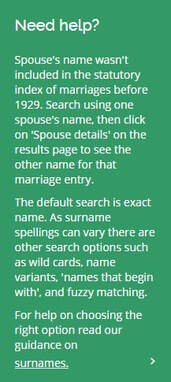
Tips
The search screens have a little slider switch in blue prefixed "Turn Off Tips". Don't. This is a useful little feature that only activates green information boxes when you chose an option from a drop-down menu. Some of the advice is a bit bland, but some of it can be a very useful reminder of what there is, and what there is not, in the underlying data. If you are not finding what you hoped, check the tips and see if that might explain things. As in this example, you might be directed to more help too e.g. surname guidance which is very informative. |
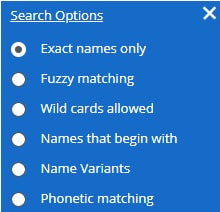
Name Searching The default is to search for exact names. I recommend that you make a conscious effort to use several different choices for the same search in order to find as many candidates as possible. There can be a lot of variation in spellings, especially in the old parish registers. See my page on Wildcard Searching for some tips for this option. Phonetic matching can be quite good for overcoming transcription errors. Name Variants is a good one for educating yourself on just how much a name can vary and you are reaping the benefit of lots of contributions from staff and online users. It is also a good one to use for forenames which have been abbreviated in a way that wildcards might not always pick up. That same surname guidance page will tell you more about these options. |

Gender
You can narrow down searches immediately by gender - the default is to search for both. I recommend that you leave this as it is for initial searches as there may well be several candidates that are marked as "U" for Unknown.
There may be no forename for example, often the case for the burials of babies and infants. Another reason for this may be that transcribers may have been unfamiliar with some more unusual Scottish names and have not been able to assign a gender to the record - Grizzell is one of my favourite old names for a girl! Also, did you know that both Christian and Stewart were quite common forenames for girls in some of the earlier records? You can always narrow down a very large group later to just recognisable males or females, but don't forget about the unknowns.
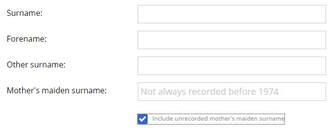
Married Woman and Widows
Once you start buying a few post 1855 death records, you will be delighted to discover that mother's maiden names are also recorded in many registration districts and have often been indexed too. This is invaluable when searching for the deaths of both men and women. It is not always indexed though, so be sure to check the box to include unrecorded mother's maiden surnames too, or you risk ignoring valuable records.
But did you know that married women and widows also have their own maiden names indexed? If you put this surname into the box called Other surname it is a great way of narrowing down long candidate lists when the married name is not uncommon. The maiden name will not show up in the result list, but you can prove to yourself that you have got the right woman by reversing the names in the query boxes - put her maiden name in the Surname box and her married named in the Other surname box and repeat the query. Compare all the other information returned by the 2 queries and you should see that it is the same. Here's an example of what I mean - 2 index results for the same death record:
Once you start buying a few post 1855 death records, you will be delighted to discover that mother's maiden names are also recorded in many registration districts and have often been indexed too. This is invaluable when searching for the deaths of both men and women. It is not always indexed though, so be sure to check the box to include unrecorded mother's maiden surnames too, or you risk ignoring valuable records.
But did you know that married women and widows also have their own maiden names indexed? If you put this surname into the box called Other surname it is a great way of narrowing down long candidate lists when the married name is not uncommon. The maiden name will not show up in the result list, but you can prove to yourself that you have got the right woman by reversing the names in the query boxes - put her maiden name in the Surname box and her married named in the Other surname box and repeat the query. Compare all the other information returned by the 2 queries and you should see that it is the same. Here's an example of what I mean - 2 index results for the same death record:
You can also use a variation on this technique to find out if a woman married. Query her death in her maiden name and note any promising candidates, particularly if the mother's maiden name was indexed and the age at death and registration year allow you to calculate an approximate birth year that make for a good match. Now query again but this time don't include a surname, just a forename, age, year and registration district. If this query returns a pair of records like those above, then you will have discovered her married name and can go hunting for the marriage. Be warned though, this is not foolproof - I've found women I know to have been married only appearing in the indexes in their maiden names, which suggests that the corresponding married name record is missing from the index.
One other thing to watch out for in Scotland, is that widows sometimes reverted to their maiden names. If you cannot find your widowed ancestor in a census, then try searching for her under her maiden name - I've found a couple of ancestors this way. Old Parish Registers might also record the burial of widows as simply that - "Widow Gerrity" for example. Transcribers have recorded 'Widow' as the forename so be sure to search on just the surname in your chosen parish too to make sure you don't miss out on a possible match for your woman. Incidentally, although there are no monumental inscriptions on ScotlandsPeople, this was also a very common practice on Scottish gravestones - you will often find the wife engraved with her maiden name.
One other thing to watch out for in Scotland, is that widows sometimes reverted to their maiden names. If you cannot find your widowed ancestor in a census, then try searching for her under her maiden name - I've found a couple of ancestors this way. Old Parish Registers might also record the burial of widows as simply that - "Widow Gerrity" for example. Transcribers have recorded 'Widow' as the forename so be sure to search on just the surname in your chosen parish too to make sure you don't miss out on a possible match for your woman. Incidentally, although there are no monumental inscriptions on ScotlandsPeople, this was also a very common practice on Scottish gravestones - you will often find the wife engraved with her maiden name.
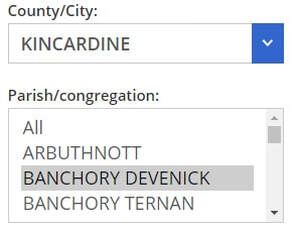
Drop-down Choices
The drop-down choices generally apply to place names - counties, parishes and registration districts for example. I recommend that you do an open query - no names - for the place you are interested in to establish whether there are actually any records of the type you want. This particularly applies to deaths and burials in the old parish registers for example which are very sparse.
For example. you can legitimately choose the parish of Banchory Devenick for the county of Kincardine but there are in fact no burial records online - you'll be a long time faffing about with trying to find your relative with no success before that dawns on you, trust me! I just wish that ScotlandsPeople would tell you they don't have any records of that type for the parish instead of just telling you to keep recomposing your search criteria.
For more detailed observations and advice, then do visit my Searching Scottish Parishes on ScotlandsPeople page.
The drop-down choices generally apply to place names - counties, parishes and registration districts for example. I recommend that you do an open query - no names - for the place you are interested in to establish whether there are actually any records of the type you want. This particularly applies to deaths and burials in the old parish registers for example which are very sparse.
For example. you can legitimately choose the parish of Banchory Devenick for the county of Kincardine but there are in fact no burial records online - you'll be a long time faffing about with trying to find your relative with no success before that dawns on you, trust me! I just wish that ScotlandsPeople would tell you they don't have any records of that type for the parish instead of just telling you to keep recomposing your search criteria.
For more detailed observations and advice, then do visit my Searching Scottish Parishes on ScotlandsPeople page.
Sorting Results
Once you have a set of results for any search, click on any of the column titles to sort them in either ascending or descending order. This will help you identify groups of records that might reveal interesting patterns e.g. groups of siblings being baptised in the same parish or to the same parents in the old parish registers. Sort by gender to group together all the "unknown" records so you can study these separately and understand why there was no gender assigned. Sort by year to reveal perhaps an older sibling who must have died for your ancestor to be given the same name.
Once you have a set of results for any search, click on any of the column titles to sort them in either ascending or descending order. This will help you identify groups of records that might reveal interesting patterns e.g. groups of siblings being baptised in the same parish or to the same parents in the old parish registers. Sort by gender to group together all the "unknown" records so you can study these separately and understand why there was no gender assigned. Sort by year to reveal perhaps an older sibling who must have died for your ancestor to be given the same name.
Finding Maiden Names of Mothers of Young Children
Perhaps you have found a man of interest in the next census who now appears to be married with a clutch of young children under 10. Who did he marry? With common names it might not be immediately obvious which marriage to choose as the most likely one from the indexes - there could be several John Scott's all marrying a woman named Mary in the local area in the right time frame. You could buy all the likely candidates until you lucked upon the right one, but here's a technique to narrow down the possibilities when there were several children born after 1855.
You're going to have to work forwards and backwards with different types of records, but that's the challenge isn't it and why you are reading this advice?!
Perhaps you have found a man of interest in the next census who now appears to be married with a clutch of young children under 10. Who did he marry? With common names it might not be immediately obvious which marriage to choose as the most likely one from the indexes - there could be several John Scott's all marrying a woman named Mary in the local area in the right time frame. You could buy all the likely candidates until you lucked upon the right one, but here's a technique to narrow down the possibilities when there were several children born after 1855.
You're going to have to work forwards and backwards with different types of records, but that's the challenge isn't it and why you are reading this advice?!
- Note the registration district that the family were living in from the census record you have found.
- Working on the assumption that the family have been living in the area for a few years, focus on the youngest child and search for them in the birth indexes in the same registration district. Remember, especially in urban areas where families flocked together, there could be several Helen Scott's all born in the same timeframe named for the mother of the brothers who all moved to Glasgow to lay gas pipes! Note down the mother's maiden name for each candidate. Remember to use wildcards too, to make sure you don't miss any likely entries.
- Now search for any other older siblings by name within a suitable timeframe using the maiden name(s) you have found. Start by restricting your search to the same registration district and be sure to check the box that will include any records where the mother's maiden name had not been indexed too. Hopefully, you should start to see a pattern building up that matches the census siblings. Perhaps the older siblings are not showing up? Remove the restriction on the registration district and see if they start showing up in another registration district. Remember, it was very common for women to have their first child or children surrounded by the support of their mother and sisters at home perhaps. This might also be a very useful pointer as to the registration district or parish which she married in too.
- Follow the family forward into the next census and note any further children and repeat the technique to further corroborate the mother's maiden name you think is the most likely one. Check back to your list of marriage candidates and choose the one that matches this name.
- One thing to watch out for though is where a man may have been married briefly to another woman and had a child or children with them, all of whom have died in between the censuses! Yup, I've found this!
- Another bonus of hunting for patterns of childrens' names with matching mother's maiden names is that you will also find the children who were born and died without ever appearing on a census (remember, mother's maiden name is usually in the death indexes too and you can corroborate your findings this way.) This can reveal incredibly sad stories - I found one family who had lost 7 of their 10 children as infants this way.
(c) Irish Geneaography - 2024



